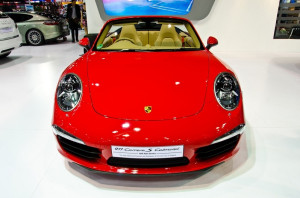« Articles
Why The Porsche 911 Cabriolet Is The Ultimate Vehicle

Where does the heart belong? Certainly, with the beat of our own blood. And if a car’s heartbeat is anything to judge by, then you know that the new Porsche 911 Cabriolet is a special kind of Porsche. It’s not just another new variant on a model but something much more significant than that. The new Porsche 911 Cabriolet marks an end and a beginning for Porsche as we know it. For the first time ever, the base model in the range is no longer the entry-level version but instead comes as a more affordable alternative to the standard Cabriolet S with PDK transmission which remains top dog in its segment once again. So what exactly makes this car so special? Let us explain why it’s easily become our favorite Porsche so far .
The new generation
Porsche has been building one of the world’s best sports cars for more than half a century now, and the Porsche 911 has seen more than 15 different generations over that time. This latest version is a major leap forward in terms of technology, design, and performance. It comes with a new turbocharged 3-liter engine and an all-new suspension system alongside a host of other new and improved features. The new Porsche 911 Cabriolet is the first generation of the Porsche 911 model family to be based on the new 991-platform that has been used for all 991 variants since it was introduced back in 2011. The new Porsche 911 Cabriolet is the first sports car that is being built as an electric vehicle from the ground up. This means that it is designed around an electric drive system, which can be configured for different drive modes. Specifically, the new Porsche 911 Cabriolet is the first sports car to be equipped with a lithium-ion battery.
A more muscular look for our beloved Porsche 911
The new Porsche 911 Cabriolet marks a subtle but decisive shift away from the sleek elegance of the previous generation to a more muscular, aggressive design language. The design changes are subtle but significant, particularly in the looks of the front end, where the latest Cabriolet gets a black-painted finish for the iconic Porsche power dome hood (as on the S model), plus a new front bumper with larger intakes and integrated LED fog lights. At the rear, the new Cabriolet gets a slightly reshaped bumper and light design but retains the iconic “ducktail” engine cover. The Cabriolet S comes with a sportier body kit with larger intakes and a black-painted rear spoiler. The rest of the look remains the same, though, with the iconic Porsche 911 shape that has become an automotive design icon.
More power, more torque and a new PDK transmission
The new Porsche 911 Cabriolet powerplant is now a 3-liter, water-cooled 6-cylinder turbocharged engine with a single twin-scroll turbocharger that has been completely redesigned. The result is a significant increase in power and torque across the board: 20 horsepower and 30 lb. ft. of torque are added at the low end, while the high-end power is boosted by 35 horsepower and 40 lb. ft. of torque. The increase in power and torque is so significant that Porsche has a new transmission to go with it. The current 7-speed manual transmission has been phased out, replaced by the brand-new 8-speed Porsche dual clutch transmission for the new Porsche 911 Cabriolet.
Welcome return of the naturally aspirated flat-six engine
The naturally aspirated 3.0-liter flat-six engine is back as standard with the Porsche 911 Cabriolet T, as well as with the Cabriolet S and the Porsche 911 Cabriolet 4 models. The new engine with its optimized fuel injection, exhaust valves and pistons, as well as its modified crankshaft now has 380 horsepower (up from 350) and 310 lb.-ft. of torque (up from 280), which is more than sufficient to make the Porsche 911 a dream to drive whether on the track or on the open road. The standard Porsche 911 Cabriolet with the naturally aspirated flat-six engine delivers an average fuel consumption of 12.9 l/100 km (combined) in both the EU and U.S. cycle (with CO2 emissions of 295 g/km or less). When fitted with the Porsche Turbo Charging System (as on the Cabriolet S), the new engine’s power is increased to 410 horsepower.
Lightweight chassis with advanced driving aids
The Porsche 911 Cabriolet is based on a lightweight chassis with an all-new, highly rigid and lightweight construction made from a mix of materials including aluminum, magnesium and high-strength steel. The aim is to provide a dynamic driving experience with the ride quality of a luxury car, while also providing excellent handling and performance. The Porsche 911 Cabriolet is equipped with a wide range of driving aids including the new Porsche Active Aerodynamics (PAA) system, which controls the air flow around the car and the optional Porsche Dynamic Chassis Control (PDCC) system, which works together with Porsche Torque Vectoring (PTV) to enhance the car’s handling and driving characteristics.
Conclusion
There’s no doubt that the new Porsche 911 Cabriolet is a more powerful machine than its predecessor, but it’s not just the new drivetrain that’s done wonders for this car. The Porsche 911 has always been a design icon, but this latest model is a true beauty in every sense of the word, from nose to tail. And it’s everything that we want a Porsche to be and then some. It’s as close to perfection as you can get in a sports car.
Featured Video
The fastest Porsche 911 ever made | Turbo S
The Porsche 911 has a turbo boost button but you only have 20 seconds...

Comment using Facebook